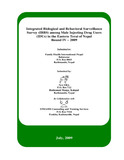Please use this identifier to cite or link to this item:
https://hdl.handle.net/20.500.14356/766Full metadata record
| DC Field | Value | Language |
|---|---|---|
| dc.contributor.author | New ERA | |
| dc.date.accessioned | 2012-12-27T23:23:53Z | |
| dc.date.accessioned | 2022-11-08T10:20:09Z | - |
| dc.date.available | 2012-12-27T23:23:53Z | |
| dc.date.available | 2022-11-08T10:20:09Z | - |
| dc.date.issued | 2009 | |
| dc.identifier.uri | http://103.69.126.140:8080/handle/20.500.14356/766 | - |
| dc.description.abstract | This study presents the findings of the fourth round of the IBBS conducted among IDUs of the Eastern Terai region of Nepal. The study is based on a survey of 345 males aged 16 years and above who have been injecting illicit drugs for at least three months prior to the date of the survey. The IDUs were recruited from different areas of the Jhapa, Sunsari and Morang districts of the Eastern Terai. The objective of the study was to determine the prevalence of HIV/STIs and to assess HIV/STI-related risk behavior among the IDUs in the study areas. The study also collected information on IDUs’ socio-demographic characteristics, awareness of HIV/STIs, sexual behavior, condom use and exposure to intervention programs in the study areas. The fieldwork started on 19 January and was completed on 23 February 2009. Study Methodology The sample size was determined by using a basic statistical formula which estimated a size of 345 samples. Two-stage cluster sampling was used to draw the sample. In the first stage, 30 clusters were selected using the probability proportional to the size (PPS) method and in the second stage 15 respondents were selected randomly from each selected clusters. A quantitative research approach was adopted in the study. Structured questionnaires were used to collect behavioral data among the IDUs. In order to draw up a comparative analysis of the behavioral trends over the years, questions asked during the previous rounds were repeated. Strict confidentiality was maintained throughout the study process. The respondents were provided a unique ID number. The same ID number was used on the questionnaire, medical records, and blood specimens of the particular respondents. All respondents participated voluntarily in the study. Those who did not meet the study criteria and those who were not willing to participate were not involved in the study. The study was conducted in compliance with both ethical and human rights standards. These standards included participants’ anonymity as well as pre- and post-test counseling. ‘Ethical’ as well as ‘technical’ approval was obtained from Family Health International’s ethical review body, the Protection of Human Subject Committee (PHSC), and the Nepal Health Research Council (NHRC) prior to the commencement of the fieldwork. Informed consent was obtained in the presence of a witness from all the participants prior to the interview and the collection of blood samples. Laboratory Methods Syphilis was tested for using the Rapid Plasma Regain (RPR) test card and confirmed by means of the Serodia Treponema Pallidium ParticleAgglutination (TPPA) test. Treponema Pallidum Particle Agglutination (TPPA)-positive and all samples with positive RPR were further tested for the titre of up to 64 times dilution. HIV was detected by using Determine HIV 1/2 (Abbott Japan Co. Ltd.) as a first test to detect antibodies against HIV. If the first test showed a negative result then no further test was conducted but if the first test was positive, the second test was performed using Uni-Gold (Trinity Biotech, Dublin, Ireland). In case of a tie between the first two tests, a third test was performed using SD Bioline HIV 1/2 (Standard Diagnostics, Inc., Kyonggi-do, South Korea) as a tie-breaker test. Key Findings Overall, 8.1 percent of IDUs tested HIV-positive. A history of syphilis was found among 1.7 percent of the IDUs, while 1.7 percent of the study participants currently had high-titre syphilis. The prevalence ofHIV was significantly high (p<0.05) among IDUs aged 20 years and above, who were ever married, and who had been injecting drugs for more than five years. One-third of IDUs had beeninjecting drugs for more than five years. The past week’s injecting practice indicated that 17 percent had shared their needles/syringes with others at least once, 14.5 percent had injected with other’s used needles/syringes, and 10.7 percent of respondents had used a needle/syringe kept in a public place. About 92 percent of IDUs had had sexual contact before. Of these, 71.5 percent had been sexually active in the past year. Nearly 45 percent of respondents used condoms consistently with sex workers, 23.7 percent with non-regular partners, and 5.6 percent with regular sex partners. Consistent condom use with all sex partners had decreased compared to 2007. Overall, 95.4 percent of IDUs were aware of all three main prevention measures namely, (A) abstinence from sex, (B) being faithful to one sex partner, and (C) regular condom use. Around96 percent of IDUs knew that a confidential HIV testing facility was available in their communities. However, 38 percent of them had never taken up HIV testing before. Nearly 91 percent of IDUs had met PEs/OEs, 87.5 percent had visited a DIC and 33.6 percent had visited a VCT center at least once in the past year. However, very few (6.1%) had visited an STI clinic. About 86 percent of respondents had participated in HIV/AIDS awareness programs or similar community events before the survey. | en_US |
| dc.language.iso | en_US | en_US |
| dc.publisher | Family Health International /Nepal | en_US |
| dc.title | Integrated Biological and Behavioral Surveillance Survey (IBBS) among Male Injecting Drug Users (IDUs) in the Eastern Terai of Nepal Round IV – 2009 | en_US |
| dc.type | Technical Report | en_US |
| Appears in Collections: | Post Graduate Grant (PG) Reports | |
Items in DSpace are protected by copyright, with all rights reserved, unless otherwise indicated.

